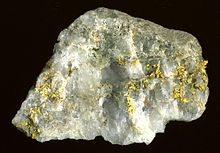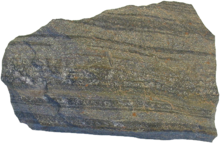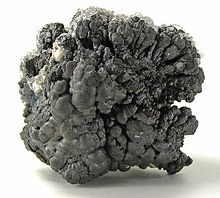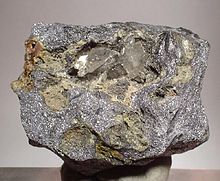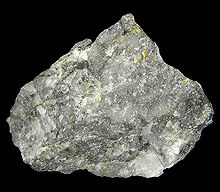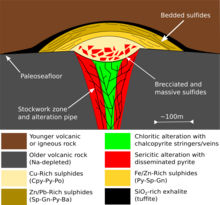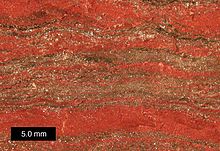Surface coal mine with haul truck in foreground
Mining engineering is an engineering discipline that applies science and technology to the extraction of minerals from the earth. Mining engineering is associated with many other disciplines, such as mineral processing, Exploration, Excavation, geology, and metallurgy, geotechnical engineering and surveying. A mining engineer may manage any phase of mining operations – from exploration and discovery of the mineral resource, through feasibility study, mine design, development of plans, production and operations to mine closure.
With the process of Mineral extraction, some amount of waste and uneconomic material are generated which are the primary source of pollution in the vicinity of mines. Mining activities by their nature cause a disturbance of the natural environment in and around which the minerals are located. Mining engineers must therefore be concerned not only with the production and processing of mineral commodities,
but also with the mitigation of damage to the environment both during
and after mining as a result of the change in the mining area. Such
Industries go through stringent laws to control the pollution and damage
caused to the environment and are periodically governed by the
concerned departments.
History of mining engineering
From prehistoric times to the present, mining has played a significant role in the existence of the human race. Since the beginning of civilization people have used stone and ceramics and, later, metals found on or close to the Earth's surface. These were used to manufacture early tools and weapons. For example, high quality flint found in northern France and southern England were used to set fire and break rock. Flint mines have been found in chalk
areas where seams of the stone were followed underground by shafts and
galleries. The oldest known mine on archaeological record is the "Lion
Cave" in Swaziland. At this site, which radiocarbon dating indicates to be about 43,000 years old, paleolithic humans mined mineral hematite, which contained iron and was ground to produce the red pigment ochre.
The ancient Romans were innovators of mining
engineering. They developed large scale mining methods, such as the use
of large volumes of water brought to the minehead by numerous aqueducts for hydraulic mining. The exposed rock was then attacked by fire-setting where fires were used to heat the rock, which would be quenched with a stream of water. The thermal shock cracked the rock, enabling it to be removed. In some mines the Romans utilized water-powered machinery such as reverse overshot water-wheels. These were used extensively in the copper mines at Rio Tinto in Spain, where one sequence comprised 16 such wheels arranged in pairs, lifting water about 80 feet (24 m).
Black powder was first used in mining in Banská Štiavnica, Kingdom of Hungary (present-day Slovakia) in 1627. This allowed blasting of rock and earth to loosen and reveal ore veins, which was much faster than fire-setting. The Industrial Revolution saw further advances in mining technologies, including improved explosives and steam-powered pumps, lifts, and drills as long as they remained safe.
Education
Colorado School of Mines
There are many ways to become a Mining Engineer but all include a university or college degree. Primarily, training includes a Bachelor of Engineering (B.Eng. or B.E.), Bachelor of Science (B.Sc. or B.S.), Bachelor of Technology (B.Tech.) or Bachelor of Applied Science (B.A.Sc.) in Mining Engineering. Depending on the country and jurisdiction, to be licensed as a mining engineer a Master's degree; Master of Engineering (M.Eng.), Master of Science (M.Sc or M.S.) or Master of Applied Science (M.A.Sc.) maybe required.
There are also mining engineers who have come from other disciplines e.g. from engineering fields like Mechanical Engineering, Civil Engineering, Electrical Engineering, Geomatics Engineering, Environmental Engineering or from science fields like Geology, Geophysics, Physics, Geomatics, Earth Science, Mathematics, However, this path requires taking a graduate degree such as M.Eng, M.S., M.Sc. or M.A.Sc. in Mining Engineering after graduating from a different quantitative undergraduate program in order to be qualified as a mining engineer.
The fundamental subjects of mining engineering study usually include:
- Mathematics; Calculus, Algebra, Differential Equations, Numerical Analysis
- Geoscience; Geochemistry, Geophysics, Mineralogy, Geomatics
- Mechanics; Rock mechanics, Soil Mechanics, Geomechanics
- Thermodynamics; Heat Transfer, Work (thermodynamics), Mass Transfer
- Hydrogeology
- Fluid Mechanics; Fluid statics, Fluid Dynamics
- Geostatistics; Spatial Analysis, Statistics
- Control Engineering; Control Theory, Instrumentation
- Surface Mining; Open-pit mining
- Underground mining (soft rock)
- Underground mining (hard rock)
- Computing; MATLAB, Maptek (Vulcan), Golden Software (Surfer), MicroStation, Carlson
- Drilling and blasting
- Solid Mechanics; Fracture Mechanics
In the United States,
about 14 universities offer B.S. degree in mining and/or mineral
engineering. The top rated universities include Colorado School of
Mines, Pennsylvania State University, Virginia Tech, the University of
Kentucky, the University of Arizona, South Dakota School of Mines and Technology etc. A complete list can be accessed from smenet.org. Most of these universities offer M.S. and Ph.D. degrees too.
In Canada, McGill University offers both undergraduate (B.Sc. or B.Eng.) and graduate (M.Sc. or M.S.) degrees in Mining Engineering. and the University of British Columbia in Vancouver offers a Bachelor of Applied Science (B.A.Sc.) in Mining Engineering and also graduate degrees (M.A.Sc. or M.Eng and Ph.D.) in Mining Engineering.
In Europe most programs are integrated (B.S. plus M.S. into one) after the Bologna Process and take 5 years to complete. In Portugal, the University of Porto offers a M.Eng. in Mining and Geo-Environmental Engineering and in Spain the Technical University of Madrid offers degrees in Mining Engineering with tracks in Mining Technology, Mining Operations, Fuels and Explosives, Metallurgy.
In South Africa, leading institutions include the University of Pretoria,
offering a 4-year Bachelor of Engineering (B.Eng in Mining Engineering)
as well as post-graduate studies in various specialty fields such as
rock engineering and numerical modelling, explosives engineering,
ventilation engineering, underground mining methods and mine design; and the University of the Witwatersrand offering a 4-year Bachelor of Science in Engineering (B.Sc.(Eng.)) in Mining Engineering as well as graduate programs (M.Sc.(Eng.) and Ph.D.) in Mining Engineering.
Some Mining Engineers go on to pursue Doctorate degree programs such as Doctor of Philosophy (Ph.D., DPhil), Doctor of Engineering
(D.Eng., Eng.D.) these programs involve a very significant original
research component and are usually seen as entry points into Academia.
Salary and statistics
Mining
salaries are usually determined by the level of skill required, where
the position is, and what kind of organization the engineer is working
for. When comparing salaries from one region to another, cost of living and other factors need to be taken into consideration.
Mining engineers in India earn relatively high salaries in comparison to many other professions,
with an average salary of $15,250. However, in comparison to mining
engineer salaries in other regions, such as Canada, the United States,
Australia and the United Kingdom, Indian salaries are low. In the United States, there are an estimated 6,150 employed mining engineers, with a mean yearly salary of U.S. $103,710.
Pre-mining
The Prospector by N. C. Wyeth, 1906
Mineral exploration is the process of finding ores (commercially viable concentrations of minerals) to mine. Mineral exploration is a much more intensive, organized and professional form of mineral prospecting
and, though it frequently uses the services of prospecting, the process
of mineral exploration on the whole is much more involved.
The foremost stage of mining starts with the process of finding
and exploration of the mineral deposit. In the initial process of
mineral exploration, however, the role of geologists and surveyors is prominent in the pre-feasibility study
of the future mining operation. Mineral exploration and estimation of
reserve through various prospecting methods are done to determine the
method and type of mining in addition to profitability condition.
Mineral discovery
Once
a mineral discovery has been made, and has been determined to be of
sufficient economic quality to mine, mining engineers will then work on
developing a plan to mine this effectively and efficiently.
The discovery can be made from research of mineral maps, academic
geological reports or local, state, and national geological reports.
Other sources of information include property assays, and local word of
mouth. Mineral research usually include the sampling and analysis of
sediments, soil and drill-core. Soil sampling and analysis is one of the
most popular mineral exploration tools.
Common tools include satellite and airborne photographs or aiborne
geophysics, including magnetometric and gamma-spectrometric maps.
Unless the mineral exploration is done on public property, the owners
of the property may play a significant role in the exploration process,
and may be the original discoverer of the mineral deposit.
Mineral determination
After
a prospective mineral is located, the mining geologist and/or mining
engineer then determines the ore properties. This may involve chemical
analysis of the ore to determine the composition of the sample. Once the
mineral properties are identified, the next step is determining the
quantity of the ore. This involves determining the extent of the deposit
as well as the purity of the ore.
The geologist drills additional core samples to find the limits of the
deposit or seam and calculates the quantity of valuable material present
in the deposit.
Feasibility study
Once the mineral identification and reserve amount is reasonably determined, the next step is to determine the feasibility
of recovering the mineral deposit. A preliminary study shortly after
the discovery of the deposit examines the market conditions such as the
supply and demand of the mineral, the amount of ore needed to be moved
to recover a certain quantity of that mineral as well as analysis of the
cost associated with the operation. This pre-feasibility study
determines whether the mining project is likely to be profitable; if it
is then a more in-depth analysis of the deposit is undertaken. After the
full extent of the ore body is known and has been examined by
engineers, the feasibility study examines the cost of initial capital
investment, methods of extraction, the cost of operation, an estimated
length of time to payback, the gross revenue and net profit margin,
any possible resale price of the land, the total life of the reserve,
the total value of the reserve, investment in future projects, and the
property owner or owners' contract. In addition, environmental impact,
reclamation, possible legal ramifications and all government permitting
are considered.
These steps of analysis determine whether the mine company should
proceed with the extraction of the minerals or whether the project
should be abandoned. The mining company may decide to sell the rights to
the reserve to a third party rather than develop it themselves, or the
decision to proceed with extraction may be postponed indefinitely until
market conditions become favorable.
Mining operation
Mining engineers working in an established mine may work as an engineer for operations improvement, further mineral exploration,
and operation capitalization by determining where in the mine to add
equipment and personnel. The engineer may also work in supervision and
management, or as an equipment and mineral salesperson. In addition to
engineering and operations, the mining engineer may work as an
environmental, health and safety manager or design engineer.
The act of mining required different methods of extraction depending on the mineralogy, geology, and location of the resources. Characteristics such as mineral hardness, the mineral stratification, and access to that mineral will determine the method of extraction.
Generally, mining is either done from the surface or underground.
Mining can also occur with both surface and underground operations
taking place on the same reserve. Mining activity varies as to what
method is employed to remove the mineral.
Surface mining
Surface mining comprises 90% of the world's mineral tonnage output. Also called open pit mining,
surface mining is removing minerals in formations that are at or near
the surface. Ore retrieval is done by material removal from the land in
its natural state. Surface mining often alters the land characteristics,
shape, topography, and geological make-up.
Surface mining involves quarrying which is excavating minerals by means of machinery such as cutting, cleaving, and breaking. Explosives
are usually used to facilitate breakage. Hard rocks such as limestone,
sand, gravel, and slate are generally quarried into a series of benches.
Strip mining is done on softer minerals such as clays and
phosphate are removed through use of mechanical shovels, track dozers,
and front end loaders. Softer Coal seams can also be extracted this way.
With placer mining, minerals can also be removed from the bottoms of lakes, rivers, streams, and even the ocean by dredge mining. In addition, in-situ
mining can be done from the surface using dissolving agents on the ore
body and retrieving the ore via pumping. The pumped material is then set
to leach for further processing. Hydraulic mining is utilized in forms
of water jets to wash away either overburden or the ore itself.
Mining process
Blasting:
Explosives are used to break up a rock formation and aid in the collection of ore in a process called blasting.
Blasting utilizes the heat and immense pressure of the detonated
explosives to shatter and fracture a rock mass. The type of explosives
used in mining are high explosives
which vary in composition and performance properties. The mining
engineer is responsible for the selection and proper placement of these
explosives, in order to maximize efficiency and safety. Blasting occurs
in many phases of the mining process, such as development of
infrastructure as well as production of the ore.
Leaching:
Leaching is the loss or extraction of certain materials from a carrier into a liquid (usually, but not always a solvent). Mostly used in rare-earth metals extraction.
Flotation:
Flotation (also spelled floatation) involves phenomena related to the relative buoyancy of minerals. It is the most widely used metal separate method.
Electrostatic separation:
Separating minerals by electro-characteristic differences.
Gravity separation:
Gravity separation
is an industrial method of separating two components, either a
suspension, or dry granular mixture where separating the components with
gravity is sufficiently practical.
Magnetic separation:
Magnetic separation is a process in which magnetically susceptible material is extracted from a mixture using a magnetic force.
Hydraulic separation:
Hydraulic separation is a process that using the density difference to separate minerals. Before hydraulic separation, minerals were crushed into uniform size; because minerals have uniform size and different density will have different settling velocities in water, and that can be used to separate target minerals.
Mining health and safety
Legal attention to Mining Health and Safety began in the late 19th
century and in the subsequent 20th century progressed to a comprehensive
and stringent codification of enforcement and mandatory health and
safety regulation. A mining engineer in whatever role they occupy must
follow all federal, state, and local mine safety laws.
United States
The United States Congress, through the passage of the Federal Mine Safety and Health Act of 1977, known as the Miner's Act, created the Mine Safety and Health Administration (MSHA) under the US Department of Labor.
This comprehensive Act provides miners with rights against
retaliation for reporting violations, consolidated regulation of coal
mines with metallic and nonmetallic mines, and created the independent Federal Mine Safety and Health Review Commission to review MSHA's reported violations.
The Act as codified in Code of Federal Regulations § 30 (CFR §
30) covers all miners at an active mine. When a mining engineer works at
an active mine he or she is subject to the same rights, violations,
mandatory health and safety regulations, and mandatory training as any
other worker at the mine. The mining engineer can be legally identified
as a "miner."
The Act establishes the rights of miners. The miner may report at
any time a hazardous condition and request an inspection. The miners
may elect a miners' representative to participate during an inspection,
pre-inspection meeting, and post-inspection conference. The miners and
miners' representative shall be paid for their time during all
inspections and investigations.
Mining and the environment
United States
Land reclamation is regulated for surface and underground mines
according to the Surface Mining Control and Reclamation Act of 1977. The
law creates as a part of the Department of Interior, the Bureau of
Surface Mining (OSM). OSM states on their website, “OSM is charged with
balancing the nation’s need for continued domestic coal production with
protection of the environment.”
The law requires that states set up their own Reclamation
Departments and legislate laws related to reclamation for coal mining
operations. The states may impose additional regulations and regulate
other minerals in addition to coal for land reclamation.



